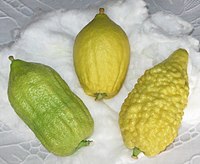The Kabbad refers to a citron-like fruit or citrus hybrid which was first described in 1963 by the Moroccan professor Henri Chapot, in his article named "Le Cédrat Kabbad et deux autres variétés de cédrat", who remarked it to be a biological hybrid between the citron and the orange sourcing from Damascus, Syria.[1]
| Citron varieties |
|---|
 |
| Acidic-pulp varieties |
| Non-acidic varieties |
| Pulpless varieties |
| Citron hybrids |
| Related articles |
Following is from The Citrus Industry vol. 1 Chap.4:
Fruits Resembling the Citron. — There are numerous fruits in which citron characters are strongly pronounced. The lumias of the Mediterranean basin are natural hybrids in which acid citron or lemon and pummelo characters are evident. According to Chapot (1950a), they are characterized by fruits of large size, commonly somewhat pyriform, with highly acid flesh of greenish color, large purple-tinged flowers, and young shoot growth both pubescent and purple-tinted. Chapot states that the principal clonal varieties are "Poire du Commandeur", "Citron de Borneo" (Chapot, 1964d), and "Pomme d'Adam". They are of ancient and unknown origin, presumably Italian, and are grown only as curiosities or ornamentals. The giant-fruited "Sui Khar" citron of Punjab State (Hodgson, Singh and Singh, 1963), the "Kabbad" citron of Damascus (Chapot, 1963f), and the "yemmakaipuli" of Coorg (India) also appear to fall in this group.
References[edit]
External links[edit]
- Photo of a kabbad
- Kabbat at Agris, Food and Agriculture Organization of the UN
- The Arabian Nights: Tales of 1,001 Nights: Volume 3
- "What Is This Armenian Mystery Fruit?"
Well, that’s interesting to know that Psilotum nudum are known as whisk ferns. Psilotum nudum is the commoner species of the two. While the P. flaccidum is a rare species and is found in the tropical islands. Both the species are usually epiphytic in habit and grow upon tree ferns. These species may also be terrestrial and grow in humus or in the crevices of the rocks.
View the detailed Guide of Psilotum nudum: Detailed Study Of Psilotum Nudum (Whisk Fern), Classification, Anatomy, Reproduction